
Guide dogs are assistance dogs trained to lead blind and visually impaired people around obstacles. Although dogs can be trained to navigate various obstacles, they are red–green color blind and incapable of interpreting street signs. The human does the directing, based on skills acquired through previous mobility training. The handler might be likened to an aircraft's navigator, who must know how to get from one place to another, and the dog is the pilot, who gets them there safely. In several countries guide dogs, along with most service and hearing dogs, are exempt from regulations against the presence of animals in places such as restaurants and public transportation.

In general, an assistance dog, known as a service dog in the United States, is a dog trained to aid or assist an individual with a disability. Many are trained by an assistance dog organization, or by their handler, often with the help of a professional trainer.

The Bernese Mountain Dog is a large-sized breed of dog, one of the four breeds of Sennenhund-type dogs from the Swiss Alps. Bred from crosses of Mastiffs and guard-type breeds, Bernese Mountain Dogs were brought to Switzerland by the Romans 2,000 years ago. The name Sennenhund is derived from the German Senne and Hund (hound/dog), as they accompanied the alpine herders and dairymen called Senn. Berner refers to the area of the breed's origin, in the canton of Bern. This breed was originally kept as a general farm dog. Large Sennenhund in the past were also used as draft animals, pulling carts. The breed was officially established in 1912.

A husky is a sled dog used in the polar regions. One can differentiate huskies from other dog types by their fast pulling-style. They represent an ever-changing crossbreed of the fastest dogs. Humans use huskies in sled-dog racing. Various companies have marketed tourist treks with dog sledges for adventure travelers in snow regions. Huskies are also kept as pets, and groups work to find new pet homes for retired racing and adventure-trekking dogs.
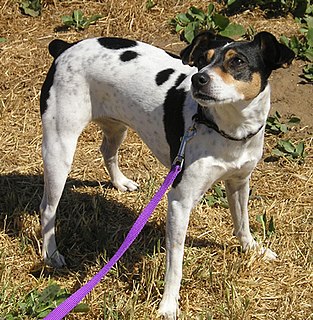
A leash is a rope or similar material used to control an animal by attaching it to a collar, harness, or halter.

Breed-specific legislation (BSL) is a type of law that prohibits or restricts particular breeds or types of dog. Such laws range from outright bans on the possession of these dogs, to restrictions and conditions on ownership, and often establishes a legal presumption that such dogs are dangerous or vicious. Some jurisdictions have enacted breed-specific legislation in response to a number of fatalities or maulings involving pit bull–type dogs or other dog breeds commonly used in dog fighting, and some government organizations such as the United States Army and Marine Corps have taken administrative action as well. Due to opposition to such laws, anti-BSL laws have been passed in 21 of the 50 state-level governments in the United States, prohibiting or restricting the ability of jurisdictions within those states to enact or enforce breed-specific legislation.

A therapy dog is a dog that is trained to provide affection, comfort and support to people, often in settings such as hospitals, retirement homes, nursing homes, schools, libraries, hospices, or disaster areas. In contrast to assistance dogs, which are trained to assist specific patients with their day-to-day physical needs, therapy dogs are trained to interact with all kinds of people, not just their handlers.

Crate training is the process of teaching a pet to accept a dog crate or cage as a familiar and safe location. Advocates claim that dogs are den-dwelling animals and that a crate can become a den substitute. Regardless, most puppies can learn to tolerate crate training if it is introduced properly. The initial stress from being confined can give way to "increased feelings of security, safety, and comfort" after repeated exposure to the crate. Long-term or excessive crate confinement "may lead to emotional and behavioral deterioration over time." On the other hand, if properly done, crate training can play a major role in housebreaking a dog as fast as possible. Ordinarily, it is seen as a way of confining a dog and restricting its movement and freedom. However, crate training can help dogs gain full bowel and bladder control while enjoying treats and comfort. If crate training is not taken seriously, the dog may start soiling around the house.
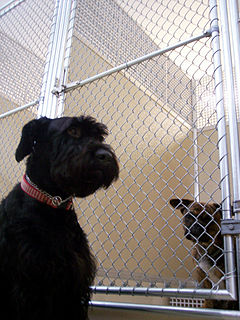
A kennel is a structure or shelter for dogs or cats. Used in the plural, the kennels, the term means any building, collection of buildings or a property in which dogs or cats are housed, maintained, and bred. A kennel can be made out of various materials, the most popular being wood and canvas.

The dog is a domesticated carnivore of the family Canidae. It is part of the wolf-like canids, and is the most widely abundant terrestrial carnivore. The dog and the extant gray wolf are sister taxa as modern wolves are not closely related to the wolves that were first domesticated, which implies that the direct ancestor of the dog is extinct. The dog was the first species to be domesticated, and has been selectively bred over millennia for various behaviors, sensory capabilities, and physical attributes.

A dog crate is a metal, wire, plastic, or fabric enclosure with a door in which a dog may be kept for security or transportation. Dog crates are designed to replicate a dog's natural den and as such can provide them with a place of refuge at home or when traveling to new surroundings. Other common reasons for using a dog crate are for toilet training a new puppy, transporting a dog, limiting access while the dog learns rules, ensuring the dog's safety, confining a dog in locations where dogs cannot safely or legally roam freely, or giving a dog a place to go when visitors come to the house.

Point Isabel Regional Shoreline in Richmond, California, is operated by East Bay Regional Park District, and is a multi-use park for joggers, windsurfers, kayakers, photographers, picnickers, and people walking dogs. It has access for pedestrians and via public transit, private vehicles, and bikes. It also features a concession offering food for people and grooming for pets. A longtime community organization and nonprofit, Point Isabel Dog Owners and Friends (PIDO), is active in the maintenance and improvement of the park.

Lighthouse Park is a neighbourhood park located in a residential area in West Vancouver. It is a popular tourist attraction for visitors to Vancouver as it is a National Historic Site of Canada. It is a well-maintained park, and is open year-round throughout all four seasons. The park is known for the Point Atkinson Lighthouse, located at the southernmost tip of the peninsula. The park is made up of 75 hectares of mostly virgin rainforest, and was founded in 1792. The District of West Vancouver maintains and operates the park and permits visitors from 7:00 a.m. to 10:00 p.m. Visitors to this park can enjoy the various beginner level hiking trails, as well as bring their dogs for a walk or have lunch along the rocks of the beach near the Lighthouse. There are various picnic benches scattered throughout the trails of the park, yet none near the beach and the lighthouse itself.

Dog walking is the act of a person walking with a dog, typically from the dog's residence and then returning. Leashes are commonly used for this. Both owners and pets receive many benefits, including exercise and companionship.
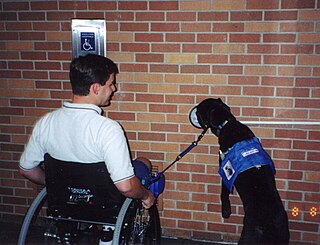
Service animals are working animals that have been trained to perform tasks that assist disabled people. Service animals may also be referred to as assistance animals, assist animals, or helper animals depending on the country and the animal's function.
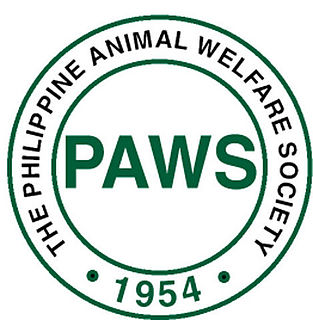
The Philippine Animal Welfare Society (PAWS) is a volunteer-based, non-government organization whose goal is to prevent animal cruelty through education, animal sheltering and advocacy, based in Quezon City, Philippines. PAWS believes that the creation of a more peaceful society starts with the widening of mankind's circle of compassion which includes animals, thereby envisions a nation that respects animals, practices responsible pet ownership and protects wildlife. The volunteer-based organization rehabilitates these animals in the hope of finding them new homes and a second chance at a good life. PAWS does not take in pets of other people, but only victims of cruelty or neglect where the animal offenders are charged with violation of the Animal Welfare Act in court.

Pet carriers are small portable boxes, crates, or cages used to transport small animals such as cats, lap dogs, miniature pigs, ferrets, chickens, guinea pigs, and so on, from one location to another.

Dog daycare, often known as "doggy daycare", refers to a short-term daytime care for dogs. It fills a niche between multi-day kennel boarding and pet sitting, where the sitter comes to the pet's home. It shares many similarities with a regular daycare for children, with the exception being that a dog daycare is for canines. The two share the same philosophy. Parents, or in the case of the dog daycare, owners, have a busy schedule and the often prolonged hours at work drastically reduce the time that could be spent with their children or pets.

Wag Labs is an American pet care company that offers a technology platform to enable on-demand and scheduled dog walking, training, and other petcare services through a mobile application. According to its website, Wag! services are insured and every pet caregiver passes through a vetting process and extensive background check before being approved to accept work on the platform. The app has been referred to as "the Uber for Dogs". The company’s tagline is “Wag! creates joy for dogs and those who love them.” Wag! donates a portion of walk proceeds to GreaterGood.org’s Rescue Bank and has, to date, provided more than 10 million meals to shelter dogs in the US.
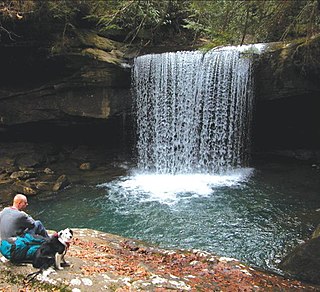
Dog Slaughter Falls is a 15 feet (4.6 m) to 20 feet (6.1 m) tall waterfall at the confluence of the Cumberland River and Dog Slaughter Creek, in the London Ranger District of the Daniel Boone National Forest in Whitley County, Kentucky. It is accessible via the Sheltowee Trace Trail, traveling downstream of Cumberland Falls, or via the Dog Slaughter Trail. The falls is rumored to be named for the drowning of unwanted pets, or the loss of hunting dogs to predatory wildlife.



















